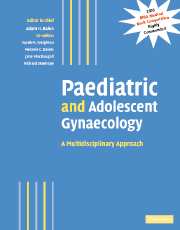Book contents
- Frontmatter
- Contents
- Contributors
- Preface
- Part I Normal development
- Part II Management of developmental abnormalities of the genital tract
- Part III Management of specific disorders
- 18 Disorders of growth and puberty
- 19 Turner's syndrome
- 20 Androgen insensitivity syndromes
- 21 Rokitansky syndrome and other Müllerian anomalies
- 22 The XY female
- 23 The gynaecology of the major genitourinary anomalies
- 24 Congenital adrenal hyperplasia
- 25 Long-term sequelae of genital surgery
- 26 Amenorrhoea
- 27 The polycystic ovary syndrome and adolescent women
- 28 Menstrual disorders in adolescent girls
- 29 Pelvic pain, ovarian cysts and endometriosis in adolescent girls
- 30 Premature ovarian failure and ovarian ageing
- 31 Gynaecological cancers in childhood
- 32 Late reproductive sequelae of treatment for childhood cancer
- 33 Preservation of fertility before cancer therapy
- 34 The management of infertility with surrogacy and egg donation
- 35 Dermatological conditions of the female genitalia
- 36 Vaginal discharge
- 37 Psychological gender development in individuals born with ambiguous genitalia
- 38 Eating disorders in adolescence
- 39 Nutritional amenorrhoea: long-term sequelae
- 40 How to set up a service: how to teach and train
- Index
- Plate section
- References
25 - Long-term sequelae of genital surgery
from Part III - Management of specific disorders
Published online by Cambridge University Press: 04 May 2010
- Frontmatter
- Contents
- Contributors
- Preface
- Part I Normal development
- Part II Management of developmental abnormalities of the genital tract
- Part III Management of specific disorders
- 18 Disorders of growth and puberty
- 19 Turner's syndrome
- 20 Androgen insensitivity syndromes
- 21 Rokitansky syndrome and other Müllerian anomalies
- 22 The XY female
- 23 The gynaecology of the major genitourinary anomalies
- 24 Congenital adrenal hyperplasia
- 25 Long-term sequelae of genital surgery
- 26 Amenorrhoea
- 27 The polycystic ovary syndrome and adolescent women
- 28 Menstrual disorders in adolescent girls
- 29 Pelvic pain, ovarian cysts and endometriosis in adolescent girls
- 30 Premature ovarian failure and ovarian ageing
- 31 Gynaecological cancers in childhood
- 32 Late reproductive sequelae of treatment for childhood cancer
- 33 Preservation of fertility before cancer therapy
- 34 The management of infertility with surrogacy and egg donation
- 35 Dermatological conditions of the female genitalia
- 36 Vaginal discharge
- 37 Psychological gender development in individuals born with ambiguous genitalia
- 38 Eating disorders in adolescence
- 39 Nutritional amenorrhoea: long-term sequelae
- 40 How to set up a service: how to teach and train
- Index
- Plate section
- References
Summary
Introduction
The role of genital surgery in the treatment of intersex conditions is under intense scrutiny at present. The need for genital surgery must be urgently evaluated. The advent of well-organized support groups for intersex conditions has given patients the confidence to express their concerns and a platform from which to do so. There is increasing evidence from the patient support groups of dissatisfaction with surgery (AISSG, 2001; The Times, 2001). Adult patients feel damaged by their genital surgery, which in many cases was done before they were old enough to consent or to understand the long-term implications. In addition, some more thoughtful surgeons are recommending greater caution with the surgical approach to the treatment of intersex conditions (Schober, 1998). Patient dissatisfaction has led to a call in some quarters for a moratorium on genital surgery (ISNA, 2001).
Crucial to the debate on the role of genital surgery are data on the long-term outcome of surgery. Unfortunately, there are very few studies of adult patients with intersex conditions that look at psychosexual function and outcome. Although surgeons operate with the intention of improving the psychosocial and psychosexual outcome, there is little long-term follow-up of these children into adult life to confirm that this approach is the correct one. There is no evidence base on which to plan treatment and counsel patients. This may be because surgery is performed by paediatric surgeons who would not then follow their patients into adulthood.
- Type
- Chapter
- Information
- Paediatric and Adolescent GynaecologyA Multidisciplinary Approach, pp. 327 - 333Publisher: Cambridge University PressPrint publication year: 2004
References
- 4
- Cited by



